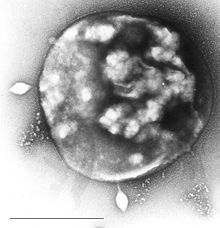Crenarchaeota
| Crenarchaeota | |
|---|---|
 |
|
| Archaea Sulfolobus infected with specific virus STSV-1. | |
| Scientific classification | |
| Domain: | Archaea |
| Kingdom: | "Crenarchaeota" |
| Phylum: | "Crenarchaeota" |
| Class | |
|
|
| Synonyms | |
|
|
The Crenarchaeota (Greek for "spring old quality" as specimens were originally isolated from geothermally heated sulfuric springs in Italy) (also known as Crenarchaea or eocytes) are Archaea that have been classified as a phylum of the Archaea domain. Initially, the Crenarchaeota were thought to be sulfur-dependent extremophiles but recent studies have identified characteristic Crenarchaeota environmental rRNA indicating the organisms may be the most abundant archaea in the marine environment. Originally, they were separated from the other archaea based on rRNA sequences; other physiological features, such as lack of histones, have supported this division, although some crenarchaea were found to have histones. Until recently all cultured Crenarchaea had been thermophilic or hyperthermophilic organisms, some of which have the ability to grow at up to 113 °C. These organisms stain Gram negative and are morphologically diverse having rod, cocci, filamentous and oddly shaped cells.
One of the best characterized members of the Crenarcheota is Sulfolobus solfataricus. This organism was originally isolated from geothermally heated sulfuric springs in Italy, and grows at 80 °C and pH of 2–4. Since its initial characterization by Wolfram Zillig, a pioneer in thermophile and archaean research, similar species in the same genus have been found around the world. Unlike the vast majority of cultured thermophiles, Sulfolobus grows aerobically and chemoorganotrophically (gaining its energy from organic sources such as sugars). These factors allow a much easier growth under laboratory conditions than anaerobic organisms and have led to Sulfolobus becoming a model organism for the study of hyperthermophiles and a large group of diverse viruses that replicate within them.
...
Wikipedia
